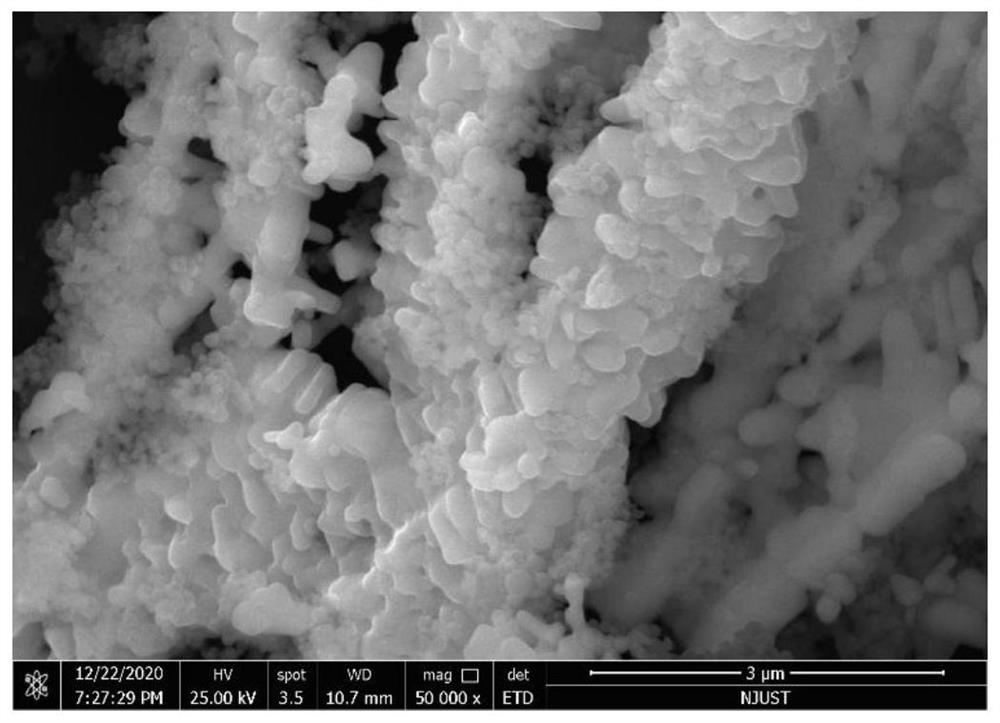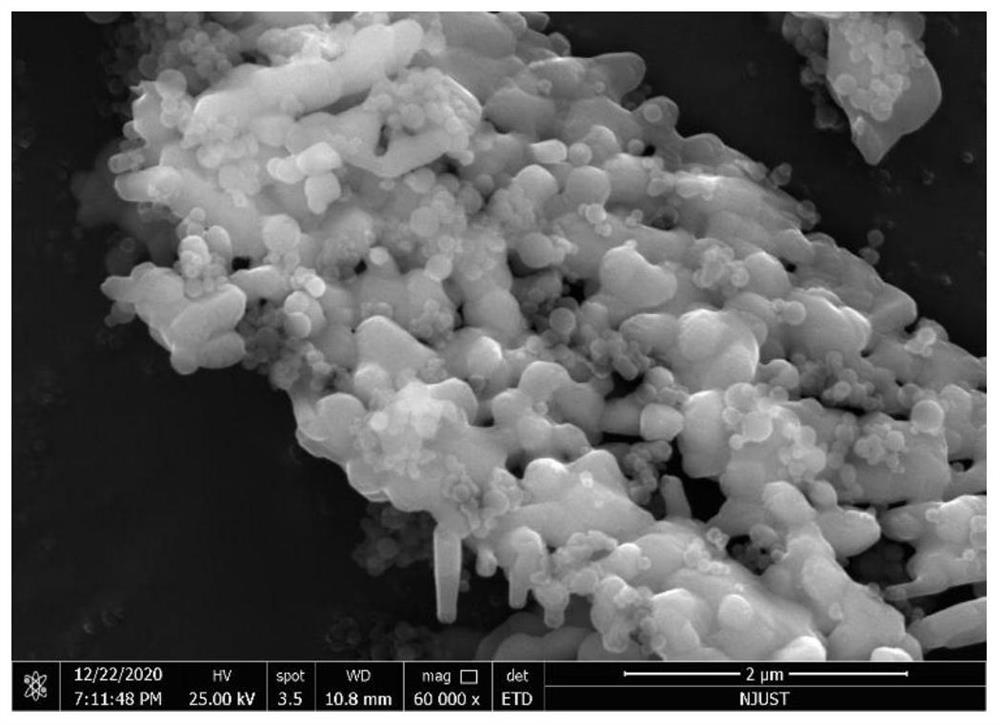Method for preparing nano aluminum/porous copper oxide nano thermite through P4VP self-assembly
A copper oxide and nano-aluminum technology, applied in copper oxide/copper hydroxide, non-explosive/non-thermal agent components, offensive equipment, etc., can solve the problems of poor product consistency, shortened mass transfer distance of reactants, and high equipment requirements
- Summary
- Abstract
- Description
- Claims
- Application Information
AI Technical Summary
Problems solved by technology
Method used
Image
Examples
Embodiment 1
[0025] Step 1: 12.08 g of three hydrolyzate copper and 3.003 g of urea were dissolved in 500 mL of deionized water, stirred for 30 min.
[0026] Step 2: Pour the solution in step 1 in a high pressure hydraulic kettle for hydrothermal synthesis, the reaction temperature is 130 ° C, the reaction time is 4 h.
[0027] Step 3: Wash the product by filtration, deionized water, water absolute ethanol, and dried to obtain a porous oxide precursor.
[0028] Step 4: The precursor is calcined using a muffer furnace, and the calcination temperature is 500 ° C, the calcination time is 4 h.
[0029] Step 5: Dissolve 0.1 g of P4VP in 100 mL of isopropyl alcohol, then 0.346 g of nano-aluminum powder, ultrasonic dispersed 1 h.
[0030] Step 6: 1 g of sheet-shaped porous calcium oxide was added to 100 ml of isopropanol, and the ultrasonic dispersion was dispersed, and the time was 1 h.
[0031] Step 7: Using magnetic stirring dispersed the nano-aluminum powder suspension in step 5, then poured into...
Embodiment 2
[0035] Step 1: 12.08 g of three hydrolyzate copper and 3.003 g of urea were dissolved in 500 mL of deionized water, stirred for 30 min.
[0036] Step 2: Pour the solution in step 1 in a high pressure hydraulic kettle for hydrothermal synthesis, the reaction temperature is 130 ° C, the reaction time is 4 h.
[0037] Step 3: Wash the product by filtration, deionized water, water absolute ethanol, and dried to obtain a porous oxide precursor.
[0038] Step 4: The precursor is calcined using a muffer furnace, and the calcination temperature is 500 ° C, the calcination time is 4 h.
[0039] Step 5: Dissolve 0.2 g of P4VP in 100 mL of isopropyl alcohol, then 0.346 g of nano-aluminum powder, ultrasonic dispersed 1 h.
[0040] Step 6: 1 g of sheet-shaped porous calcium oxide was added to 100 ml of isopropanol, and the ultrasonic dispersion was dispersed, and the time was 1 h.
[0041] Step 7: Using magnetic stirring dispersed the nano-aluminum powder suspension in step 5, then poured into...
Embodiment 3
[0044] Step 1: 12.08 g of three hydrolyzate copper and 3.003 g of urea were dissolved in 500 mL of deionized water, stirred for 30 min.
[0045] Step 2: Pour the solution in step 1 in a high pressure hydraulic kettle for hydrothermal synthesis, the reaction temperature is 130 ° C, the reaction time is 4 h.
[0046] Step 3: Wash the product by filtration, deionized water, water absolute ethanol, and dried to obtain a porous oxide precursor.
[0047] Step 4: The precursor is calcined using a muffer furnace, and the calcination temperature is 500 ° C, the calcination time is 4 h.
[0048] Step 5: Dissolve 0.2 g of P4VP in 100 mL of isopropyl alcohol, then 0.484 g of nano-aluminum powder, ultrasonic dispersed 1 h.
[0049] Step 6: 1 g of sheet-shaped porous calcium oxide was added to 100 ml of isopropanol, and the ultrasonic dispersion was dispersed, and the time was 1 h.
[0050]Step 7: Using magnetic stirring dispersed the nano-aluminum flour suspension in step 5, then poured into a...
PUM
 Login to View More
Login to View More Abstract
Description
Claims
Application Information
 Login to View More
Login to View More - R&D
- Intellectual Property
- Life Sciences
- Materials
- Tech Scout
- Unparalleled Data Quality
- Higher Quality Content
- 60% Fewer Hallucinations
Browse by: Latest US Patents, China's latest patents, Technical Efficacy Thesaurus, Application Domain, Technology Topic, Popular Technical Reports.
© 2025 PatSnap. All rights reserved.Legal|Privacy policy|Modern Slavery Act Transparency Statement|Sitemap|About US| Contact US: help@patsnap.com



